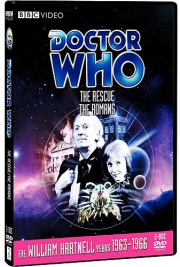Rescue & The Romans
- Sci-Fi
- 1965
- Buy the DVD
Reviewed by Ross Ruediger
()
s a “Doctor Who” fanatic, it always seems treacherous to admit that the William Hartnell era of the series is something I can take or leave. He is, after all, the first Doctor, and without the groundwork he laid through his portrayal, the show may not have lasted a season, never mind 46 years (and counting). Nevertheless, you’ll rarely find me waxing rhapsodic about the early years, because they were so very clearly aimed at children, and the pacing and production values reflect a series that was typically doing little more than entertaining the young ‘uns every Saturday afternoon. This was how “Doctor Who” started, and I understand that, but the truth is much of the Hartnell era is not particularly engaging TV by today’s standards. (Of course, I also understand that some would argue nothing within the first 26 years of the series is engaging by today’s standards, but they are, of course, wrong.)
Why all the qualifiers? Because “The Romans” reaches for something greater than most of the era in which it was produced. “The Rescue,” which is also part of this set, is far less interesting, but since it’s a two-parter, and was directed by the same man as “The Romans” (as well as preceding it chronologically), it only makes sense that the two stories are bundled together. “The Rescue” takes place right after “The Dalek Invasion of Earth,” and since the Doctor’s granddaughter, Susan, exited the series at the close of that tale, he, Ian (William Russell) and Barbara (Jacqueline Hill) are adjusting to her sudden absence. The TARDIS lands on the planet Dido, where the crew meets Vicki (Maureen O’Brien) and Bennett (Ray Barrett), two survivors of a space crash. But Bennett has a secret, and it has something to do with the alien Koquillion, who lords over the pair as they wait for a rescue ship, which should be by any day now. There isn’t anything remarkable about “The Rescue,” and it seems mostly concerned with introducing Vicki as a new companion. It’s a decent enough character piece, and there’s a surprisingly atmospheric sequence near the end when the Doctor confronts Koquillion in his underground lair – but that’s about the long and short of it.
“The Romans” begins where “The Rescue” ends – with the TARDIS materializing on a cliff side and then plummeting to the ground below. The action quickly shifts forward; it’s the year 64 A.D. and the crew has been lounging around a Roman villa for nearly a month, taking what appears to be some much needed R & R. Much of the first episode is dedicated solely to some delightfully playful characterization, and it isn’t until towards the end of the episode the real drama of the story begins to unfold. The Doctor and Vicki decide to take a trip to Rome, while Ian and Barbara stay behind, only to find themselves captured by slave traders, and sold off into very different scenarios. Meanwhile, the Doctor is mistaken for a deceased lyre player, and is summoned to play for Emperor Nero (Derek Francis). What follows is a witty comedy of errors that often seems inspired by “A Funny Thing Happened on the Way to the Forum.” While it never gets quite as crazy as “Forum,” the similarities are unmistakable, and the entire affair ends with the burning of Rome, which appears to have been caused by the Doctor’s inadvertent planting of the idea in Nero’s head.
Writer Rob Shearman, who penned the new series episode “Dalek,” claims that “The Romans” is the greatest “Doctor Who” story of the 60s. Being a slavish Patrick Troughton fan, I can’t go that far, but it may very well be the best story of Hartnell’s era; it certainly must be the best historical adventure the classic series ever did. There’s something very different about the whole thing. It has the feel of an intimate epic, if such a thing exists, and the story feels as though it travels all over Rome before it’s over. Oh, make no mistake, this is still 1965 “Who,” and it’s never going to convince anyone that it was shot on anything other than a BBC soundstage (replete with stock footage of boats and lions), but that’s right around the area where the imagination kicks in and makes this something special for its era. Hartnell is at the top of his game here, and seems to be having an immense amount of fun playing around with history; in one scene he even turns into a Doctor of action, and whoops the ass of a would-be assassin.
Russell and Hill also turn in great performances, and both Ian and Barbara, having travelled to numerous eras of history by this point, seem to have adjusted quite well to ending up in seemingly hopeless situations. The word comedy does indeed get bandied about whereas “The Romans” is concerned, and there is some funny stuff to be found here. But even more than that, the story has a great sense of adventure. Adventure is, of course, one of the primary goals of “Doctor Who,” but I’m not sure the Hartnell era is usually as successful at achieving that goal as it does here. Finally, it must be said that both of the stories on this set look gorgeous, thanks to the work of the Restoration Team. Neither installment has looked this clean in ages. A real treat this set is, especially for fans of this era of “Doctor Who.” However, if like me, your tastes in the series don’t typically stretch this far back, you may want to make an exception for this release.
Special Features: Both stories sport commentary tracks moderated by comedian/writer Toby Hadoke, and feature William Russell and director Christopher Barry, as well as a few others from the cast and crew. Despite Hadoke’s presence, the tracks are pretty stale, although they are informative; just don’t expect the same kind of fun you get out of a Davison or Tom Baker release, as the participants are fairly “seasoned” at this point. “The Rescue” features only one other extra of note, and that’s a making-of called “Mounting the Rescue.” “The Romans,” unsurprisingly, fares much better in the extras department. “What Has ‘The Romans’ Ever Done for Us?” is a 34-minute making-of that’s damn near exhaustive in its exploration of the story, as well as how it stacks up against other film and TV portrayals of ancient Rome (better than you’d think, actually!). “Roma Parva” is a short feature on a model of the set that was used to plan the story. “Dennis Spooner – Wanna Write a Television Series?” is a great little feature on the writer of “The Romans” (as well as other “Who” stories, and countless other British series such as “The Avengers” and “Thunderbirds). “Girls! Girls! Girls! – The 1960s” is a groovy look back at all the female “Who” companions from the 60s. There’s also a “Blue Peter” segment, photo galleries, production note subtitles and DVD-ROM accessible Radio Times listings and original design drawings by Raymond Cusick.
You can follow us on Twitter and Facebook for content updates. Also, sign up for our email list for weekly updates and check us out on Google+ as well.













